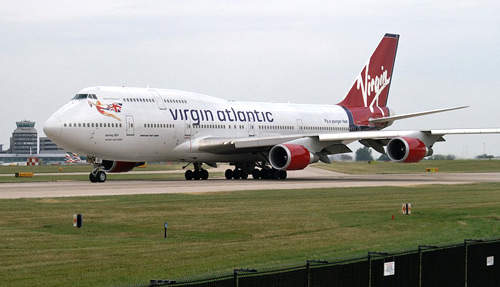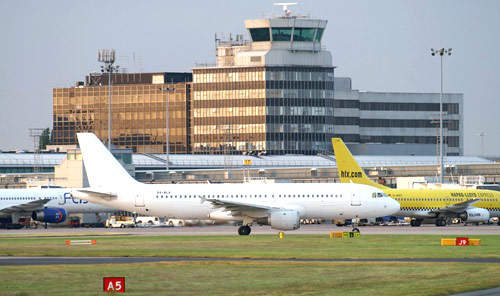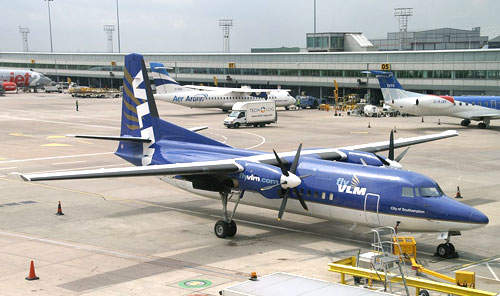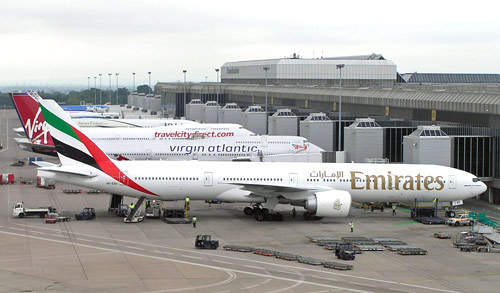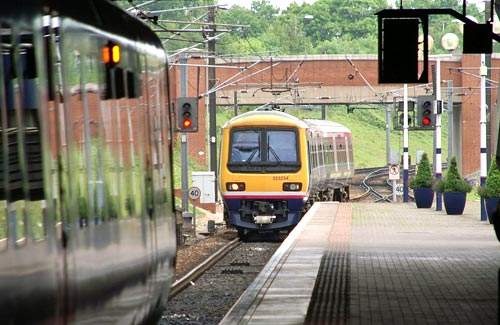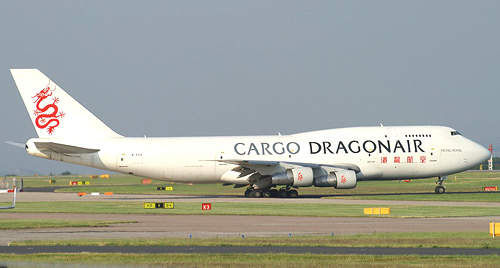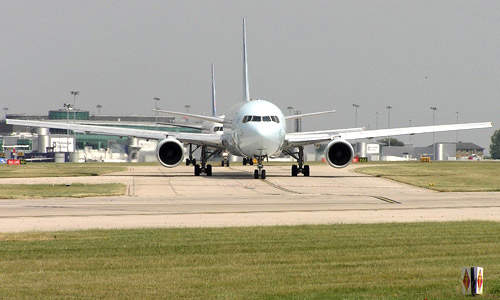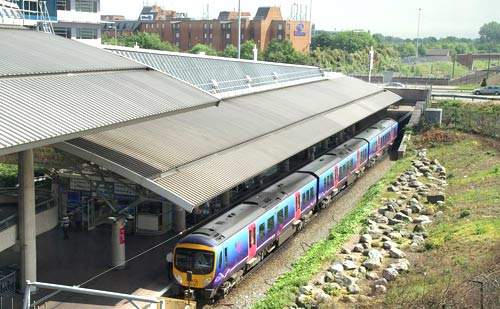Manchester Airport is on the south side of the Manchester conurbation adjoining countryside in the county of Cheshire. In spite of the airport’s standing often being expressed in terms of its secondary nature to those in the London area (as with being the UK’s busiest after Heathrow, Gatwick and Stansted), one-third of the UK’s population is within two hours’ road travel of Manchester.
Opened in June 1938 and also termed Ringway, ownership is now in the hands of ten council authorities in Greater Manchester through the Manchester Airport Group (MAG), which also owns Bournemouth, Humberside and East Midlands Airport – Nottingham, Leicester, Derby. Subsidiary body MADL (Manchester Airport Developments Ltd) handles development and management aspects of MAG. The operators forecast an increase in passenger numbers to around 32 million by 2015.
Infrastructure
Designated T1, T2 and T3, the terminals opened in 1962, 1993 and 1989 respectively. Subsequently much modified, T1 adjoins T3 and there is speculation that the designations may change in future.
Subject to high-profile and long-running environmental objections leading up to, and during, construction, Manchester opened the £172m second runway in February 2001. The project included a new fire station and substantial re-profiling of land on the south side that adjoins a country park. Runway two is subject to an agreement on restricted operating hours.
Generically designated ‘The Station’, the central transport hub receiving bus, coach and rail services has covered walkways to all terminals. The original railway station, a terminus on a spur from the ‘Styal Loop’ on the Manchester-Crewe line, opened in 1993. A second major re-engineering to increase capacity and improve train handling lead to a third platform that was opened in January 2009. The airport is integrated in the timetables of long-distance as well as local rail services.
In August 2010, Manchester Airport became the first regional airport in the world to be certified as A380 ready. It is now a Category 10 airport as it can handle the A380 and Code F aircraft.
About £10m was invested to make it A380 ready by building a new aircraft stand and installing an advance docking system. The pier was upgraded to include a pre-boarding lounge for the Emirates A380 passengers. The taxiways were also widened and perimeter fences and airfield signs relocated as part of the project.
Terminal development
The £50m overhaul of Terminal 1 was completed in July 2009. The redesign process began in 2005 and underwent many changes due to tightened security. The redevelopment included the expansion of retail and catering facilities, increased security throughput and a changed balance of passenger areas, with more space being given to airside facilities.
A new lounge, boarding area and a range of gates were added to the terminal for Airbus A380 flights.
An escape lounge was opened at T1 on 1 July 2010. T2 already features an escape lounge. A new lounge is planned for T3.
Runway
The airport has two runways, 05L/23R and 05R/23L that are 3,048m and 3,200m long respectively. Both the runways are surfaced with concrete and grooved asphalt.
Operations
In spite of a strong association with package tour operations, Manchester enjoys a broad market base within its 225 destinations with domestic, European and inter-continental areas well represented.
Route expansion by Ryanair and a new EasyJet base was announced in 2007, part of a gradual increase in the proportion of no-frills carriers in Manchester’s aircraft movements.
With a marked presence of Asian and North American routes, operations at the ‘World Freight Terminal’ include many services by wide-bodied aircraft.
To improve security, in 2008 MAG began the introduction of an iris-scanning system for staff at Manchester, the first application for staff at a UK airport.
In October 2009, Manchester airport initiated a security trial using x-ray imaging technology. The technology called Rapiscan Systems Secure 1000 Single Pose uses high definition x-rays to check passengers for concealed objects.
The new imaging technology was permanently introduced in the airport in February 2010 as part of a new Government mandated legislation. The new system replaced the existing pat down security check.
In November 2010, Biometrics in Motion trial was initiated. The trial used a technology developed by Human Recognition Systems, which is based on the iris recognition concept. The new technology does not require a passenger to stand still while their eyes are being scanned.
Rail infrastructure
With Manchester well served by motorways and an M56 exit adjacent, the airport, which has more than 21,000 parking spaces, is predominantly accessed by road. To reduce this reliance, MAG’s Ground Transport Plan includes a long-term aim for 40% of passengers and staff to use public transport.
MAG is a strong supporter of, and has signalled a financial commitment to, the Manchester Metrolink light rail network. The government gave the final approval for Metrolink’s phase 3a in May 2008.
The Greater Manchester Passenger Transport Executive (GMPTE) has ordered 28 trams for phase 3a extensions. The new rail system, based on line of sight working, is expected to be completed in October 2011.. The new Metrolink line is expected to run trams between Manchester and Central Park by Spring 2011. Phase 3b of the project will bring a line into the airport site. The line to Manchester Airport will be via Wythenshawe. In August 2010, funding was received from the Greater Manchester Transport Fund. Metrolink trams will start running to Manchester Airport by the middle of 2016. The Manchester Airports Group will contribute funds for this Metrolink line.
IT systems
Under a three-year contract Cable and Wireless will connect MADL’s four sites in Bournemouth, East Midlands, Humberside and Manchester through a multi-protocol label switched network.
The new network system will assist MADL in serving 29 million customers. It also supports corporate data applications including email, internet access and mission critical systems to support baggage handling and control power operations.
Future plans
The present T2 area has the capability of modification for higher numbers. Within the present site space was available for extension to the east of T3. Although it is possible that dedicated terminal facilities may be provided for low-cost carriers, there is no intention to add a third runway or fourth terminal.
In 2007, it was announced that the current control tower in the terminal complex built 36 years previously would be replaced. The new 60m ATC tower will be managed by the National Air Traffic Services (NATS). The new tower will require an investment of £8m and is projected for a 2013 opening.
To become a base of UK air traffic control body NATS, which also has a regional role at Manchester, the new tower is projected for a 2013 opening.
Manchester is unusual amongst UK airports in its active encouragement of visitors to see aircraft movements at close quarters and for educational purposes. Attracting around 250,000 annually, the aviation viewing park at the south west of the site is to gain a £1.1m building to house its principal exhibit, Concorde G-BOAC, during 2008. Construction of the Concorde Visitor Centre started in December 2008. It opened in February 2009.

